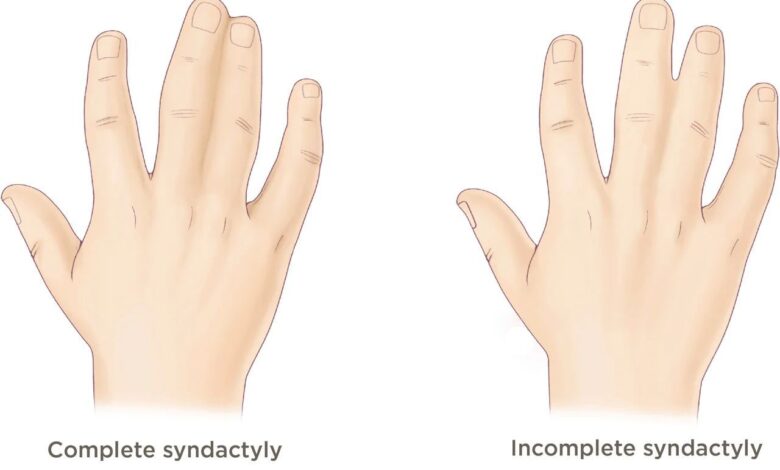Membranes between the fingers and legs, syndactyly: What's it, causes, symptoms, diagnostics, treatment, prevention

Webbing of the fingers or toes; Syndactyly; Polysyndactyly
Membranes between the fingers and legs - this is a rare innate state, known in medicine as syndactyly. It is characterized by complete or partial fingers, what can affect like a skin, and bone structures. This condition can be isolated or accompanied by other congenital anomalies. In this article, we will consider in detail the reasons, symptoms, Diagnosis and treatment of syndactylia, and also talk about prevention and care at home.
What is syndactylia?
Syndactilia is an innate defect, in which two or more fingers on the hands or legs are interconnected. This condition can be like one -sided, and bilateral, and the degree of fusion varies from the easy (when only the skin is connected) To the heavy (When the bones are fraught, Joints and nails).
Syndactilia is found approximately 1 out of 2000–3000 newborns and can be as an independent disease, so and part of the syndromes, such as Apert or Polanda syndrome syndrome. Depending on the degree of fusion, Syndactilia can affect the functionality of the limbs, especially if it affects the fingers.
It is important to note, that syndactylia is not a life -threatening state, However, it can cause psychological discomfort and limit the mobility of the fingers. Early diagnosis and treatment can minimize the consequences and improve the quality of the patient's life.
The causes of syndactylia
The exact causes of the syndactylia are not fully studied, however it is known, that this condition occurs as a result of a violation of the process of separation of the fingers during intrauterine development. At 6–8 weeks of pregnancy, the embryo begins to form fingers, And if this process is violated, There is a fusion.
Key factors, which can contribute to the development of syndactylia, include:
- genetic mutations - syndactylia is often inherited and may be associated with mutations in genes, responsible for the development of the limbs.
- Syndrome - Syndactilia can be part of genetic syndromes, such as Apert, Poland syndrome or holes syndrome.
- External factors - The effect of toxins, infections or radiation during pregnancy can increase the risk of congenital anomalies.
- Violation of the blood supply - insufficient blood supply to the extremities of the embryo can lead to improper formation of fingers.
Symptoms of syndactylia
Symptoms of syndactylia depend on the degree of fingering of the fingers. The main signs include:
- Fighting the skin - fingers are connected by the skin membrane, which can be thin or dense.
- The fusion of bones - in severe cases, the bones of the fingers can be connected, that limits their mobility.
- Nail deformation - when fought by nail phalanges, the nails can be deformed or absent.
- Limitation of mobility - fingering fingers can make it difficult to fulfill everyday tasks, such as capture of objects or walking.
- cosmetic defect -syndactylia can cause psychological discomfort due to the appearance.
When to see a doctor?
Syndactilia is usually diagnosed immediately after birth during the examination of the newborn. However, if the condition was missed, Contact the doctor if there are the following symptoms:
- Fingering fingers, which limits their mobility.
- Nail or skin deformation in the fusion area.
- Pain or discomfort in the fingered fingers.
- Psychological discomfort due to appearance.
Questions, which the doctor may ask
At the reception, the doctor may ask the following questions:
- Have there been cases of syndactylia in your family?
- Does the child have other congenital anomalies?
- How long have you noticed your fingers?
- Does the child have difficulties in performing everyday tasks?
Diagnosis of syndactylia
The diagnosis of syndactylia includes:
- Inspection - the doctor evaluates the degree of fusion and functionality of the fingers.
- Roentgen - to determine the degree of fusion of bones.
- Genetic testing - If syndactylia is part of the syndrome.
Treatment of syndactylia
Treatment of syndactylia depends on the degree of fusion and may include:
- Surgical separation of the fingers - Operation, in which the membrane is removed, And the fingers are restored.
- Physiotherapy - to restore the mobility of the fingers after surgery.
- Psychological support - to help the child in adaptation.
Home Treatment
After the operation, it is important to follow the doctor's recommendations:
- Change the bandages regularly.
- Perform exercises to restore mobility.
- Monitor the hygiene of the wound area.
Prevention of syndactylia
The prevention of syndactylia includes:
- Genetic counseling before pregnancy.
- Avoiding the effects of toxins during pregnancy.
- Regular observation by a doctor during pregnancy.
Conclusion
Syndactilia is rare, but treating condition. With timely diagnosis and treatment, you can restore the functionality and appearance of the fingers. If you notice signs of syndactylia in a child, Consult a doctor to receive professional assistance.
Sources and literature
Carrigan RB. The upper limb. In: Kliegman RM, St. Geme JW, Blum NJ, Shah SS, Tasker RC, Wilson KM, eds. Nelson Textbook of Pediatrics. 21st ed. Philadelphia, PA: Elsevier; 2020:chap 701.
Mauck BM. Congenital anomalies of the hand. In: Azar FM, Beaty JH, eds. Campbell’s Operative Orthopaedics. 14th ed. Philadelphia, PA: Elsevier; 2021:chap 80.
Son-Hing JP, Thompson GH. Congenital abnormalities of the upper and lower extremities and spine. In: Martin RJ, Fanaroff AA, Walsh MC, eds. Fanaroff and Martin’s Neonatal-Perinatal Medicine. 11th ed. Philadelphia, PA: Elsevier; 2020:chap 99.
